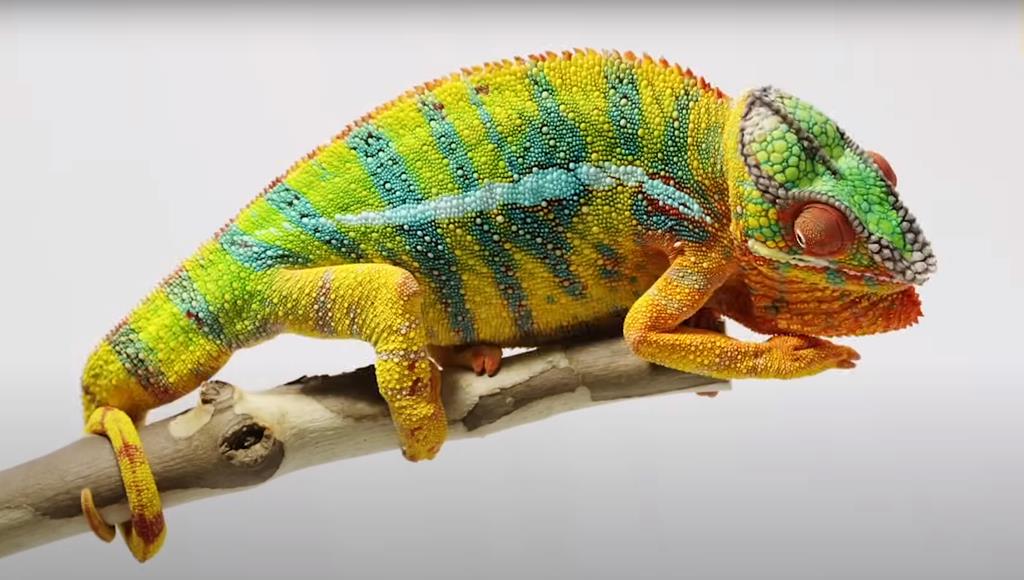A chameleon ready to lay eggs often displays a swollen abdomen and changes in behavior, such as digging. Your chameleon might also refuse food and become more restless than usual.
Chameleon caregivers face the exciting yet challenging prospect of identifying their pet’s readiness to lay eggs. This reproductive milestone is crucial for the health of a female chameleon and requires observant care. Properly understanding and recognizing the signs can ensure a successful laying process.
It involves a blend of physical and behavioral cues ranging from weight gain to color changes. Timely detection and preparation of a suitable laying environment will not only support the chameleon’s health but also foster the potential for successful hatching if the eggs are fertile. It’s essential for keepers to be informed and attentive to provide the best care for their egg-bearing chameleons.
Introduction To Chameleon Reproduction
Understanding when a chameleon is ready to lay eggs is key for any pet owner. These unique reptiles have fascinating reproductive behaviors. Knowing these can help ensure the health of both mother and offspring. Let’s dive into the life cycle of a chameleon and breeding habits in captivity.
Life Cycle Of A Chameleon
- Birth: Chameleons hatch from eggs.
- Juvenile: They grow rapidly, changing colors and developing.
- Adult: They reach sexual maturity, ready to mate and reproduce.
Many chameleons only mate once a year. This timing is crucial. Females show certain signs when they are ready to lay eggs. Look for changes in behavior, color, and appetite.
Breeding Habits In Captivity
| Stage | Signs | Action |
|---|---|---|
| Pre-mating | Females display specific colors. | Introduce male to enclosure. |
| Mating | Pairing happens, often signaled by more vivid coloration and posturing. | Ensure a stress-free environment. |
| Post-mating | Females may refuse food and start digging. | Prepare a laying bin with moist substrate. |
This breeding cycle in captivity requires careful monitoring. Keep stress levels low. Ensure optimal temperature and humidity. This helps in successful egg laying.
Physical Changes In Gravid Chameleons
Noticing your chameleon’s behavior and appearance can hint at egg-laying readiness. Physical changes are clear signs. These changes tell a tale of preparation for the next step in their life cycle. Let’s look at these transformations more closely.
Color And Pattern Shifts
Gravid, or egg-carrying, chameleons often exhibit distinctive color changes. Their patterns can become more pronounced. Brighter colors may also appear. These visual cues signal their reproductive status. They inform others to keep their distance during this vulnerable time.
Weight Gain And Body Enlargement
As eggs develop, a noticeable increase in weight occurs. The chameleon’s body visibly enlarges, especially around the abdomen. This weight gain is due to the growing eggs inside her. Look for these signs:
- Bulging Sides: The sides of the chameleon may bulge as eggs take up space.
- Heftier Heft: She’ll become heavier when you handle her.
- Appetite Changes: Her appetite might change as she prepares for laying.
A chameleon’s readiness to lay eggs marks an exciting time. Watch for these changes carefully. Doing so ensures you can provide the right care at the right time.
Behavioral Clues Indicating Laying Time
Spotting when your chameleon is ready to lay eggs can be a mystery for new owners. Yet, distinct signs hint at the approaching time. Watch for specific behaviors to ensure a comfortable environment for your chameleon’s laying process.
Digging And Restlessness
Chameleons show clear nesting behavior when egg-laying nears. Female chameleons, in particular, start digging in their enclosure. This behavior is a strong indicator of their need to establish a suitable place to lay their eggs.
- Scraping at the bottom of the cage
- Moving substrate with their nose or feet
- Trying to escape to find a nesting spot
Prepare a laying bin with plenty of moist sand and soil. This encourages natural digging behavior and offers a secure place for egg deposition.
Decreased Appetite And Activity
Another clue is a change in eating habits. Your chameleon might suddenly eat less or refuse food. This symptom, combined with less movement, signals her body conserving energy for the egg-laying process.
| Behavior | Explanation |
|---|---|
| Decreased appetite | Energy is being focused on egg development |
| Reduced activity | Conserving energy for laying eggs |
Recognizing these behaviors helps provide the best care for your chameleon during this critical time. Stay alert for these signs to create a supportive environment for your pet’s egg-laying.
Preparing The Lay Bin
Understanding when your chameleon is ready to lay eggs is vital for their health. Equally important is preparing a proper lay bin. This guide dedicates focus on creating an ideal environment for your chameleon to lay her eggs comfortably and safely.
Choosing The Right Substrate
The substrate in your lay bin serves as the bed where your chameleon will lay her eggs. It’s crucial to choose one that mimics her natural digging conditions.
Key considerations for the substrate:
- Moisture retention: It should hold humidity without being soggy.
- Texture: The substrate should be soft enough for digging but firm enough to prevent tunnels from collapsing.
- Non-toxic material: Ensure it’s free from chemicals and dyes that could harm your chameleon.
Popular choices include play sand mixed with topsoil or coconut fiber substrates.
Ideal Lay Bin Setup
Create a sanctuary for your chameleon to lay her eggs with the perfect lay bin setup.
- Size matters: The container should be large enough for your chameleon to move around and dig deep tunnels. Aim for a depth of at least 8-12 inches.
- Privacy is key: Choose a location away from daily disturbances. A secluded spot ensures your chameleon feels safe to lay her eggs.
- Optimal conditions: Keep the substrate moist and maintain the lay bin at a suitable temperature that replicates the natural breeding environment.
Remember to frequently check the moisture level of the substrate without disturbing your chameleon.
Health Considerations During Egg-laying
Caring for a female chameleon can be challenging, especially during egg-laying. Ensuring her health remains a top priority. Consider some crucial health factors when your chameleon prepares to lay eggs.
Calcium Supplementation
Calcium is vital for your chameleon during this critical time. It helps in developing strong eggshells, preventing health issues for both mother and offspring. Here’s what you need to know:
- Increase calcium intake before the laying process.
- Use a high-quality calcium supplement without D3.
- Dust the insects with calcium powder to feed her.
A balanced diet with calcium-rich insects supports her through egg development and laying. Remember to consult with a reptile veterinarian about the proper dosage.
Monitoring For Complications
Keep a close eye on your chameleon for any signs of distress. Look for these complications:
| Signs of Complication | Action to Take |
|---|---|
| Extended time digging without laying eggs | Check the laying bin for suitable conditions |
| Lethargy or decreased appetite | Consult a vet immediately |
| Swollen abdomen with no egg-laying | Seek veterinary help for possible egg binding |
Regular monitoring is a critical part of caring for your chameleon. Do not hesitate to seek professional help if you suspect any health issues. Your chameleon’s health and well-being depend on your attention and action.
Post-laying Care For Your Chameleon
After your chameleon has laid her eggs, proper care ensures her health and well-being. A focus on nutritional recovery and habitat maintenance is key. These steps help her regain strength and prevent health issues.
Nutritional Recovery
Replenishing your chameleon’s nutrition is critical after egg-laying. She has spent considerable energy during the process. Here are vital steps to help her recover:
- Boost calcium intake. Egg-laying depletes calcium. Provide calcium supplements.
- Increase food. More insects like crickets and mealworms will help. They give her energy back.
- Offer variety. A rich diet of assorted insects ensures a balance of nutrients.
- Hydration is a must. Keep fresh water available at all times. Mist her habitat more often.
- Vitamin supplements. Include vitamins A and D3. They aid in recovery and overall health.
Habitat Maintenance
Maintaining a clean and comfortable environment is essential for your chameleon’s recovery.
- Clean the enclosure. Remove any leftover food and feces.
- Check temperature. Ensure a warm basking spot and cooler areas.
- Keep humidity levels right. Chameleons need high humidity to stay hydrated.
- Inspect for parasites. Keeping the habitat clean helps prevent infestations.
| Action | Description |
|---|---|
| Cleaning | Disinfect the habitat to avoid bacteria and pathogens. |
| Plants | Ensure live plants are healthy. They provide security and humidity. |
| Substrate | Replace or clean the substrate to keep the enclosure fresh. |
Frequently Asked Questions On How Do I Know When My Chameleon Is Ready To Lay Eggs?
How Do You Know When A Chameleon Is Going To Lay Eggs?
A chameleon preparing to lay eggs often exhibits weight gain, a bulging abdomen, changes in color, and increased digging behavior. She may also become restless and refuse food before laying.
What Is The Behavior Of A Veiled Chameleon Egg Laying?
Veiled chameleon females dig deep holes to lay eggs, usually 20-70 per clutch. They cover the nest site afterward for incubation, which can last from 6-9 months depending on temperature and humidity.
How Can You Tell If A Chameleon Is Pregnant?
A pregnant chameleon may display a darker or more vivid coloration, a swollen abdomen, and reduced appetite. She might also become more aggressive and seek solitude.
How Long After Mating Do Veiled Chameleons Lay Eggs?
Veiled chameleons typically lay eggs 20 to 30 days after mating. It’s crucial for them to have a suitable laying site to encourage the process.
Conclusion
Understanding your chameleon’s behavior and physical changes is key to identifying egg-laying time. Watch for weight gain, restlessness, and digging — these are clear signs. Regular monitoring and a nurturing environment will help ensure your pet’s health during this critical period.
Remember, a well-informed owner is a chameleon’s best ally.



